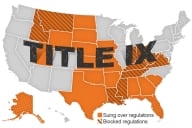You have /5 articles left.
Sign up for a free account or log in.

Fulisha Lilian Oscar
Courtesy of Fulisha Lilian Oscar
Fulisha Lilian Oscar, like many people during the pandemic, has a lot going on in her life. But hers is probably more stressful than most.
She is 36 and a student at Madera Community College in California's San Joaquin Valley.
She is also a single mother of six children, who range from being in the fourth grade to being a freshman in college.
“Yeah, I have kids at every level of school,” she said last week in an apartment where several school bags hang neatly on the hooks of a pegboard.
As in many homes, all the children are going to class remotely, sitting at the kitchen table with a small Christmas tree in the apartment she affords with the help of a federal housing voucher. And she works afternoons remotely for the college’s financial aid office.
At stake as negotiations in Congress over passing another coronavirus aid package remain stalled is whether more emergency grants are coming to students like Oscar.
She received $600 last spring, part of the $6 billion in grant aid Congress included in the CARES Act for colleges to distribute to students in need.
Oscar used part of it for earphones for her children -- “so we don’t all have to listen to each other’s Zoom classes.” The rest went for food and to keep the lights and internet on.
“It would help me keep food on the table, keep a roof over my head,” she said of more aid. But as importantly, it would help keep her mind on school when she has two classes left before graduating and going on to California State University, Fresno.
“I won’t have to worry about these things. It would take the pressure and strain off me and help me keep my mind on finishing school,” she said.
The associations representing higher education in Washington say the needs are dire for colleges and universities. They wrote congressional leaders Dec. 3 that the $120 billion in additional aid they had been seeking turned out to be far less than what their need ended up being, as the pandemic dropped enrollment, their cost of COVID-19 testing turned out to be three times as much as they anticipated and they have lost billions more in revenue in other ways, like not being able to rent out spaces for conferences.
More money is needed, they said, to prevent more furloughs and even keep some colleges afloat. But perhaps the most immediate need before Congress, say financial aid administrators, is more money for emergency grants to give out to struggling students.
Some colleges have kept some of the $6 billion the last relief bill set aside in emergency grants for students. But at many campuses, the need was so great, they have long since blown through the money.
“The money is almost gone,” Lizette Navarette, vice chancellor of college finance and facilities planning for California Community Colleges, said in an interview.
Congressional leaders are negotiating over adding more coronavirus aid to a separate funding bill they need to pass to keep the government running.
They have been unable to reach an agreement over issues like whether to include aid for states, plus a shield protecting businesses, including colleges, from coronavirus-related lawsuits, as part of COVID-19 relief.
On Friday, they passed a one-week funding bill to avert a government shutdown, giving themselves until Dec. 18 to reach a deal before leaving for the holidays.
Any coronavirus aid would be a Band-Aid intended to offer enough relief to help Americans for just the next few months until the incoming Biden administration tries to get a larger package through Congress, probably around March. Any money in the bill is expected to be a fraction of the amount in the CARES Act.
Though congressional leaders have said it’s imperative they reach a deal before leaving for the holidays, it remains unknown whether they will be able to reach a deal now or if negotiations will drag on until spring.
The pandemic has hit community college students, whose average age is around 26, hard, said Navarette. Eighty percent of the students work, not through internships, “but for living and necessity,” she said. “They tend to be employed in the service industries, and the service industries continue to plummet.”
There was more bad news for those businesses, and jobs, when Madera, like the surrounding San Joaquin Valley region, issued a stay-at-home order for at least three weeks, beginning Dec. 6, when the availability of ICU beds in the area fell below 15 percent.
“When the pandemic hit, it, in many ways, exacerbated the economic challenges our students already faced,” Navarette said.
To make matters worse, CARES Act funding was based on the number of full-time-equivalent students a college enrolled, which disadvantaged community colleges, which have more students attending part-time. As a result, two-year colleges got on average $393 per student to give out in emergency grants, compared to $1,000 on average that four-year colleges received.
Students are dropping out to find work or because they’re unable to pay for their education. Or, like Oscar, they are distracted from school as they try to provide and survive.
“If we don’t act now to provide aid so students can stay enrolled, we could have another lost generation of students,” Navarette said.
At the University of Alaska, Fairbanks, all the CARES Act funding for student emergency grants was spent last spring.
The university’s financial aid administrators had worried when the pandemic struck that many students wouldn’t ask for help, even as hotels shut down and the tourism jobs that many of the students rely on disappeared.
“It’s a cultural thing here not to ask for assistance,” said Ashley Munro, the university’s associate director of financial aid. “Alaskans tend to be very self-reliant. Regardless of whether they’re from here or move here, they embrace the challenge of living here.”
To make sure no one would struggle in silence, the university chose to give all of its CARES Act money last spring to all of its eligible students on a sliding scale, with those eligible for Pell Grants getting the most.
Since then, the university, like many colleges, has used its own funds to supplement the CARES Act money for student grants and raised money from donors. But there won’t be enough.
Munro is working mostly from home these days at a kitchen table by a window. She worries, as she looks out at the nearly all white outside the window on days like Friday, when the high temperature was 3 degrees below zero, about the people they are losing.
She talks about it on Zoom calls. “It probably gets brought up every meeting, that somebody has heard about a student who has stopped coming, but we didn’t know they were having problems until they stopped coming,” she said.
“We spent all the money for student grants by early summer,” said JoEllen Soucier, executive director of financial aid for the Houston Community College District. “We had a huge immediate need, and we spent it in the first couple of months.”
“We’re still getting requests every day,” she said. “Some are for housing assistance, food, technology, helping with utilities. Childcare. Lots of requests for childcare. Just trying to survive.”
“We’re doing the best we can. We’re applying for every grant we can,” she said. But the university had to stop taking applications for aid on Nov. 20.
As the next semester approaches in less than a month, colleges need immediate help to test for the coronavirus as much as they can, said Michael Huey, interim chief executive officer of the American College Health Association.
In July, a survey of colleges found that they anticipated spending an average of $3.7 million on coronavirus testing. They ended up spending three times as much, $9.3 million on average, the higher education associations said in their letter to Congress.
The cost increased, Huey said, because as the year progressed, colleges realized they needed to do more testing than they originally thought.
“Things have changed so quickly. The need to wear masks. We’ve learned that the more often you can test, do surveillance testing, quarantining people, the better chance you have to take the steps to counter whatever is going on,” he said.
“The one thing we can say absolutely is that the more testing, the better,” he said.
There are implications for trying to reopen campuses. Smith College is planning to house up to 1,830 students, about three-fourths of the normal number, and offer virtual learning next semester. But it is also planning to test all students for COVID-19 twice per week, following the example of institutions like Colby College and the University of Illinois at Urbana-Champaign.
Asked if there are other universities that want to do the same but lack the ability to do enough testing, Huey said, “there probably are.”
As the semester nears its end at Medaille College in Buffalo, N.Y., the stakes of what happens in Congress are apparent in how many of President Kenneth Macur's students return after the holidays.
About a third of the students are from the Buffalo school system. The median family income of those students is $25,000.
“So they’re super needy,” he said.
The CARES Act funding went toward getting students the laptops and mobile Wi-Fi connections they needed to participate remotely.
But as freshmen finish their first semester, Macur said, the college needs immediate funding to reach out to struggling students and offer whatever help they need to not give up.
“The final grades are in. A lot of kids aren’t going to do too well in their first semester,” he said. “We need more folks to get a hold of these kids and start the recovery process now, so they can not feel like a total loser and that they don’t belong.
“That’s the message many minority kids get, is that they don’t belong. We perpetuate that with messages like ‘college isn’t for everybody.’ When students hear that message and they hit a major speedbump, it reinforces the message that ‘college isn’t for me,’” he said.
“Their families are losing jobs. These are the people who lost jobs in the 2008 recession and most didn’t recover, and now they have this [pandemic] piled on top,” he said.
The college was among five the area to share a $2.9 million grant from the Bill and Melinda Gates Foundation last year to reach out to struggling students. But he said more aid now would allow the university to hire more staff to call the students.
“We don’t start by asking them about algebra. We ask, how are you and your family doing? Do we need to get you to a testing site? Do we need to connect you with mental health services? It’s winter in Buffalo -- let’s make sure you’ve got heat. Let’s connect you to legal services if you’re facing eviction. That’s the world I’m facing. The first question isn’t about algebra. It's ‘how are you doing?’”








